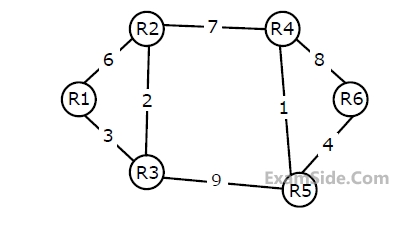
The network uses a Distance Vector Routing protocol. Once the routes have stabilized, the distance vectors at different nodes are as following
N1 : ( 0, 1, 7, 8, 4 )
N2 : ( 1, 0, 6, 7, 3 )
N3 : ( 7, 6, 0, 2, 6 )
N4 : ( 8, 7, 2, 0, 4 )
N5 : ( 4, 3, 6, 4, 0 )
After the update in the previous question, the link N1-N2 goes down. N2 will reflect this change immediately in its distance vector as cost, $$\infty $$. After the NEXT ROUND of update, what will be the cost to N1 in the distance vector of N3?
Consider a network with 6 routers R1 to R6 connected with links having weights as shown in the following diagram

All the routers use the distance vector based routing algorithm to update their routing tables. Each router starts with its routing table initialized to contain an entry for each neighbour with the weight of the respective connecting link. After all the routing tables stabilize, how many links in the network will never be used for carrying any data?
Consider a network with 6 routers R1 to R6 connected with links having weights as shown in the following diagram
 Suppose the weights of all unused links in the previous question are changed to 2 and the distance vector algorithm is used again until all routing tables stabilize. How many links will now remain unused?
Suppose the weights of all unused links in the previous question are changed to 2 and the distance vector algorithm is used again until all routing tables stabilize. How many links will now remain unused?